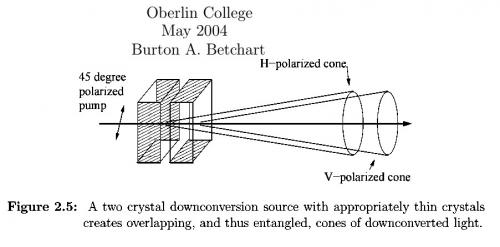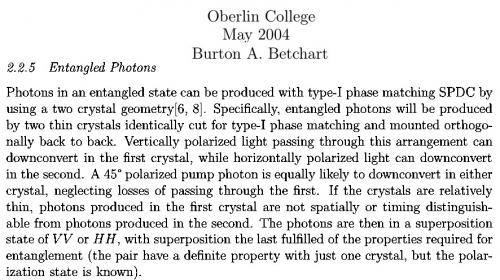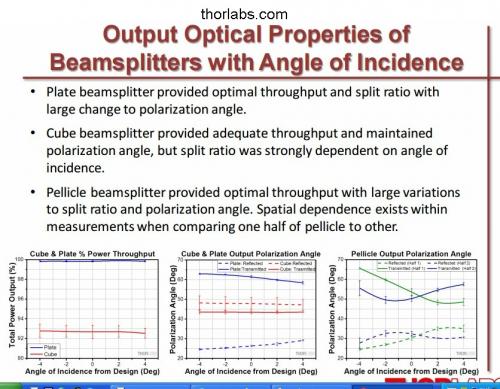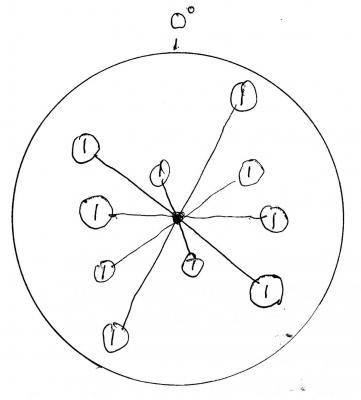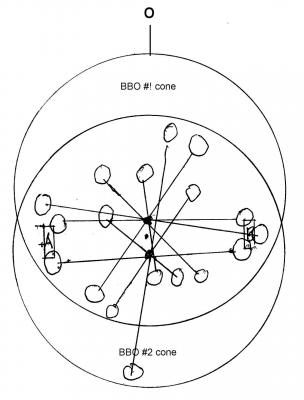

Lazarus
Senior Members-
Posts
366 -
Joined
-
Last visited
Content Type
Profiles
Forums
Events
Everything posted by Lazarus
-
Strange: You haven't shown that there is any bad assumption. (You may believe there is, but that is hardly relevant, given the level of expertise you have demonstrated.) Lazarus: There is no justification for saying the photons are indeterminate. One BBO does not create indeterminate photons. What is the reason a second independent BBO with time separation makes them indeterminate?
-
If there is a bad assumption in CHSH nothing else matters.
-
The whole point of the 25ns window is to insure the one at a time capture of pairs.
-
Its like saying Jeter’s batting average affected Babe Ruth’s batting average.
-
The problems with the CHSH experiments that I pointed out were not discredited or even addressed. They were brushed off along with snide remarks that imply that I am dumber than the rest of you so there was no point in looking at what I had to say. How can you ignore the ridiculous CHSH assumption to start off with that the photons from one BBO can have their state changed from known to indeterminate by photons at a different time from a completely independent BBO? Come on guys, open your eyes and look at the insane logic of the CHSH. Warm regards, Lazarus
- 132 replies
-
-1
-
Thank you for the many helpful comments. I don’t feel my contention that the logic of the CHSH experiments is flawed has been refuted but every one has a right to their opinion and your opinions are certainly valuable and based on a great amount of knowledge.
-
Swansont: What happens when you detect them with a polarizer at 45º, as they did in the experiment. Can you tell which crystal emitted them? Do the statistics indicate that the polarizations were either horizontal or vertical? Lazarus: There are three classes of lies, lies, damned lies and statistics. The statistician drowned in a lake three feet deep, on the average. There are 2 major logic flaws in the CHSH experiments; First: One BBO cannot produce Quantum Entangled photons. The CHSH assumption is that photons from an independent BBO at a different time can change a photon from the first BBO from a known state to a Quantum entangled state. Second: The photons reaching both detectors at the same time are in the same state. That means both detectors could be looking at the same photon and the results would not change. The rules for one of the detectors are changed. That can create almost any result.
-
The link to the Burton Betchart paper does strange things but you can get to it by putting this in the search: A Test of Bell's Inequality for the Undergraduate Laboratory This link goes to a similar description of the CHSH experiments by Enrique Galvez. This also says that a single BBO cannot entangle photons. http://spookyactionbook.com/2016/02/21/faq-how-are-entangled-particles-created-video/ -------------------------------------------------------------------------------- Here is how a Type I BBO with the pulse beam at 45 degrees works: The BBO treats half the photons as vertically polarized and half as horizontally polarized. All of the photons in one half go through unscathed. Occasionally, one of the photons in the other half splits into two lower energy photons. Both new photons are polarized in the same direction. The two new photons go in different directions. The rest of the photons that do not split also go through unscathed. -------------------------------------------------------------------------------- This is a timeline of events in a CHSH experiment: There are 2 BBO’s with one in front of the other. The A BBO is on the side of the incoming pulse beam. The B BBO is one the side of the exiting photons. BBO A is aligned horizontally. BBO B is aligned vertically. The pulse beam is aligned at 45 degrees. There are two detectors to catch the coincident events. The pulse beam produces many photons. A few of the photons are split by one of the two BBO’s and travel in different paths. The pulse beam and the entangled photons are at different frequencies so the pulse beam can be eliminated. The one billionth photon is split by BBO A, The 2 resultant photons are polarized vertically. They are only counted if both detectors are activated. The two billionth photon is split by BBO B. The 2 resultant photons are polarized vertically. The three billionth photon is split by BBO B. On and on we go, randomly seeing vertically photons from BBO A and horizontally polarized photons from BBO B. What is indeterminate here?
-
Swansont: Are you saying that reading comprehension is the issue here? Lazarus: Of course not. Just making sure that you think Burton’s experiment is not a real CHSH type experiment. It seems similar to many descriptions of CHSH. What is the difference between Burton’s and a real CHSH experiment?
- 132 replies
-
-1
-
Swansont: Not the way they did the experiment. Which is the whole point, really, and one of the things you're missing. There are lots of ways in which the photons would not be entangled. You don't do the experiment those ways. Lazarus: Are you saying that Burton Betchart’s description is not correct?
-
Swansont: You STILL haven't answered either question. "We next check that the two SPDC cones coming from the BBOs are completely overlapping by checking the polarization of the light incident on our detectors; if the cones are overlapped properly the total SPDC light cone is unpolarized. " If you think that a flashlight will work then you really need to take a giant step back and learn about entanglement before trying to attack Bell tests. Why do you think flashlight photons would have the same polarization correlation that these entangled photons would? Lazarus: The difference is the photons from the flashlight are in all 360 degrees of polarization but the photons from the BBO have just two choices of polarization. Which allows determination of the source of a photon. SwansonT You tell me what the output will be for input light polarized at 45 degrees. Lazarus: I am willing to go along with Burton Betchart’s contention that at 45 degrees all the photons from one type I BBO are all polarized at the same angle. However, if Burton’s description is correct it doesn’t matter what I think because the generated photons are not indeterminate.
-
Swansont: I asked about the output of the crystal, but even here you haven't said how the polarization could be determined, and just claimed you could do it. The output photon takes the horizontal polarization path. What was the incoming polarization? Lazarus: You are right. I am not completely comfortable with how the BBO reacts to rotation of the pulse beam. Most of the descriptions jump from alignment of the pump beam vertically to the CHSH setup with the 2 BBO’s aligned 45 degrees on either side of the pump beam. Then the output is described as horizontal from one of the BBO’s and vertical from the other. Here is an example: Not only does this say that one of the 2 type 1 BBO’s only generates vertical photons, it specifically mentions that a single BBO has its polarization known. That implies the polarization detected determines which BBO the photon came from in the CHSH experiment.
-
Swansont: Did you not understand the question? (There is nothing in my query about angle of incidence) Lazarus: The output of an absorptive polarizer set at 45 degrees is half of the light, polarized at the polarizer setting. An arriving photon has a 50-50 chance of making it through. The photons making it through have their polarization changed. The output of a beam-splitting polarizer is 2 polarized beams. At 45 degrees an arriving photon has a 50-50 chance of which beam it follows. The polarization of the incoming photons can be determined. Blinding the polarizer by changing its alignment does not change the polarization of the incoming photon. Where is anything indeterminate?
-
-
Swansont: They look at the overall output and confirm it's unpolarized as part of the testing. (2) in procedure on p.6 "We next check that the two SPDC cones coming from the BBOs are completely overlapping by checking the polarization of the light incident on our detectors; if the cones are overlapped properly the total SPDC light cone is unpolarized.“ Lazarus: The only reason that is unpolarized is that there are 2 BBO’s. Since each detection comes from 1 BBO, both of the generated photons are polarized.
-
Swansont: What center line? And no, we are not in agreement.Photons go in either direction, with either polarization. Lazarus: If both vertical and horizontal photons of a Barium Borate crystal can go in either generated beam, then the output of the BBO is unpolarized. We could use flashlights instead. If we can’t agree on this none of the rest of it matters.
-
Swansont: An experiment trying to show the Bell inequality is not trying to prove entanglement. (There's a pdf from my search that's a lab trying to demonstrate entanglement, but college lab courses are recreating known phenomenon) What does the abstract of your paper say? (You won't share information about it and said to Google it, so I don't know if I'm looking at the same paper as you) Lazarus: We are looking at the same paper if you have the Joshua Geller paper labeled Lab 1 from the Rochester University. Einstein’s EPR paper was objecting to Quantum Entanglement. The CHSH experiments claim to refute EPR. That sounds like CHSH was “proving” Quantum Entanglement. Swansont: Your repeated objection is that H or V photons are produced and you could tell the difference, but have never explained how. The BBO crystal produces polarized photons orthogonal to the polarization of the input. But the input beam to the BBO crystal is polarized at 45%, so for either crystal you don't know if it produces H or V photons, since the input is in a superposition of the states. So, explain clearly how you would tell what the polarization is, and what crystal generated the photons. Lazarus: We are in agreement that both H and V photons from both BBO’s can hit both polarizers. These experiments are restricted to cases when both detectors are activated by the photon pair. For perpendicular polarizations, the H generated photons are on one side of a center line and the V protons are always on the other side. With the setup: the A detector on the left side, the B detector on the right side, BBO’s set 45 degrees on each side of the center, BBO #1 sending the H protons to the right side and the V protons to the left and BBO #2 sending V protons right and H protons left the sequence of events can be described. When a V photon from BBO #2 hits the left detector (A), the H photon cannot hit the right detector (B) because it is left of the left detector. That event is not considered. The only pairs from BBO #2 that are considered cause the H proton to hit the left detector and the V proton to hit the right detector. With the polarizors both set at 0 degrees the polarization can be determined and which BBO generated it. BBP #1 is opposite so an H proton hitting the left detector means it came from BBO #2. Setting the polarizers at different angles defeats their ability to determine polarity but that does not change the polarization of the incoming photons any more than closing your eyes changes the color of the wall. Also, please comment on 3 of the CHSH tests being the same test of 22.5 degrees separation of the two polarizers.
-
Swansont: BINGO! And since one is trying to establish whether or not the Bell inequality holds, we want entangled photons Only if you arrange to not have entangled photons. Which is opposite of what the point of the experiment is. Lazarus: This experiment is trying to prove Quantum entanglement. We can’t assume Quantum entanglement from the start. The strange part of the CHSH experiments is that 3 of the tests are really the same and one is different. Three of the tests are set with 22.5 degrees between the polarizers and one test set at 67.5 degrees. Even the Quantum Theory assumes that only the angle between the polarizers matters.
-
Swansont: I've asked you to show this and you've failed to demonstrate it (45 and 30 degree orientations) You're going to assert it again? Seriously? Lazarus: Closing your eyes does not make the color of the wall indeterminate. The detectors in the CHSH experiments certainly have the capability to determine the polarization of the photons and allow the determination of which BBO they came from. Setting the detectors at various angles, like 30 and 45, makes it difficult or impossible to determine the polarization. The detectors cannot determine the polarization, therefore the photons are entangled. The information is available, just being ignored
-
Here is my understanding of CHSH experiments: First is the Joshua Geller version. The BBO’s are Type I so all the generated pairs are parallel entangled. The 2 BBO’s are set at 45 degrees from 0 degrees. One is +45 and the other is -45 so there is 90 degrees between them. Any spot on their cones can be hit by generated photons. Both photons in the pairs from BBO #1 are all vertically polarized. From BBO #2 all photons are horizontally polarized. Following is a cross section of a BBO cone with the paths of some typical pairs. The 2 photons in an entangled pair are symmetrically aligned with the input beams path. The 2 cones overlap with the polarizers at the extremes of the overlap. The following is a cross section at the polarizers with some typical paths of pairs. The pairs from are centered on the axis of each BBO cone. Every spot of the overlap can be hit by both vertically and horizontally polarized photons. The problem is that the BBO source is apparent because all the photons from BBO #1 are vertically polarized and protons from BBO #2 are horizontally polarized. That doesn’t really show anything indeterminant. Next the same setup but using Type II BBO’s. That way both BBO’s generate both vertical and horizontal photons. Both polarizers see a mixture of vertical and horizontally polarized photons. That sounds like we now have indeterminate photons. But wait. As Swansont pointed out in post #59, one beam goes left of center and the other goes right of center. On a coincident event the A polarizer always gets the left photon and the B polarizer always gets the right photon. That means which BBO the photons came from can be determined. The solution is for the BBO’s to reverse the beams randomly. That also causes problems.
-
Swansont: Why does it have to reverse the beams? Lazarus: If the BBO’s do not reverse beams, the photons from the “left” BBO will always arrive in the same polarization and the photons from the “right” BBO will always arrive in the other polarization because we are only looking at coincidences. That means we can determine which BBO the photons came from.
-
It appears the only real issue we have is whether A BBO can reverse beams. The rest of the differences rest on that.
-
Swansont: OK. Set it at 30. Tell me conclusively which crystal. Lazarus: An easy way to do it is to set the other polarizer at 0 degrees. If it gets a + the 30 degree polarizer got a horizontally polarized photon. Swansont: The ones used are most efficient, but they are not the only ones. The issue is what you are misunderstanding to make you think they are the only angles. Lazarus: I ran all 360 degrees on a simulation. This is all moot if a BBO can’t reverse the beams.
-
Swansont: Now, how about answering my question: When the polarizer is at 45º, how do you tell which BBO generated the photon? I didn't ask you to change the question, I asked you to answer it. Lazarus: As you suggest, if the polarizers are set to 45 degrees the result will not allow determination of the polarization of a photon or which BBO it came from. That is also true for the equivalent settings, 135, 225 and 315. All other settings allow for determining the polarization. Swansont: But the goal of this is to test the Bell inequality, rather than to test Malus's law. It's important to understand why you want the polarizers at 45º for one of the measurements. If the 45 degree settings are the only ones for which the polarization setting cannot be determined, the other setting should not be used in CHSH type experiments.
-
When one of the polarizers is set to 45 degrees the other is not set to 45. That would make it possible to determine the polarization. Also, if we were just trying to determine the polarization, we probably would not set the polarizer to 45 degrees.

